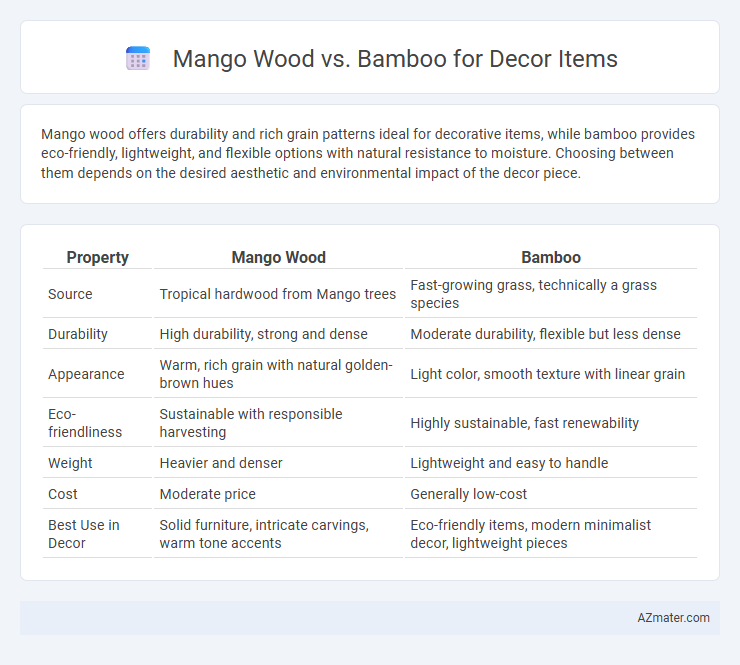Mango wood offers durability and rich grain patterns ideal for decorative items, while bamboo provides eco-friendly, lightweight, and flexible options with natural resistance to moisture. Choosing between them depends on the desired aesthetic and environmental impact of the decor piece.
Table of Comparison
| Property | Mango Wood | Bamboo |
|---|---|---|
| Source | Tropical hardwood from Mango trees | Fast-growing grass, technically a grass species |
| Durability | High durability, strong and dense | Moderate durability, flexible but less dense |
| Appearance | Warm, rich grain with natural golden-brown hues | Light color, smooth texture with linear grain |
| Eco-friendliness | Sustainable with responsible harvesting | Highly sustainable, fast renewability |
| Weight | Heavier and denser | Lightweight and easy to handle |
| Cost | Moderate price | Generally low-cost |
| Best Use in Decor | Solid furniture, intricate carvings, warm tone accents | Eco-friendly items, modern minimalist decor, lightweight pieces |
Introduction: Mango Wood vs Bamboo for Decor
Mango wood and bamboo are popular sustainable materials used in decor items, each offering unique aesthetic and functional qualities. Mango wood provides a rich, warm tone with a smooth grain, ideal for rustic and elegant furniture pieces, while bamboo is lightweight, durable, and features a natural, contemporary look suitable for minimalist designs. Both materials are eco-friendly, but mango wood is denser and typically better for solid, carved items, whereas bamboo excels in flexible, lightweight structures.
Material Origins and Sustainability
Mango wood is sourced from the mango tree, primarily cultivated in tropical regions like India, where the wood is a byproduct of fruit harvesting, promoting sustainable use of agricultural resources. Bamboo, a fast-growing grass native to Asia, regenerates quickly without the need for replanting, making it one of the most renewable materials for decor items. Both materials offer eco-friendly options, but bamboo's rapid growth and carbon sequestration capacity often give it an edge in sustainability over mango wood.
Appearance and Aesthetic Appeal
Mango wood features a warm, rich grain and smooth texture that enhances the natural beauty of decor items with its rustic charm and varied tones from light to dark brown. Bamboo offers a sleek, modern look with a consistent pale yellow color and distinctive linear grain, creating a minimalist and contemporary aesthetic. Both materials provide unique visual appeal, with mango wood delivering an earthy, handcrafted vibe while bamboo brings a clean, eco-friendly elegance to interior design.
Durability and Strength Comparison
Mango wood offers moderate durability and strength, making it suitable for lightweight decorative items that require a natural, rustic look. Bamboo, known for its exceptional tensile strength and durability, excels in creating sturdy and long-lasting decor pieces, especially those exposed to humidity or wear. Choosing bamboo over mango wood can enhance the longevity and resilience of decorative items in high-traffic or moist environments.
Maintenance and Care Requirements
Mango wood requires regular dusting and occasional polishing with wood oil to maintain its rich texture and prevent drying or cracking, while bamboo decor items need gentle cleaning with a damp cloth to avoid water damage and mildew growth. Mango wood is more prone to scratches and moisture damage, making it essential to keep it away from excessive humidity and direct sunlight. Bamboo is naturally more resistant to moisture and pests, but still benefits from periodic oiling to preserve its flexibility and sheen.
Versatility in Decor Applications
Mango wood offers exceptional versatility in decor applications due to its durability, smooth texture, and ability to be carved into intricate designs, making it ideal for furniture, wall panels, and decorative accents. Bamboo, known for its lightweight strength and natural flexibility, excels in creating eco-friendly decor items like blinds, mats, and lightweight furniture, adding a rustic and sustainable aesthetic. Both materials provide unique versatility, with mango wood suited for detailed craftsmanship and bamboo favored for minimalist, modern decor styles.
Cost and Affordability
Mango wood offers a durable and affordable option for decor items, often priced moderately due to its sustainable sourcing and rapid growth. Bamboo stands out as a cost-effective choice with its fast renewability and lower production expenses, making it highly affordable for budget-conscious consumers. Comparing cost, bamboo typically undercuts mango wood, but mango wood's unique grain and sturdiness provide added value in mid-range decor markets.
Eco-Friendliness and Environmental Impact
Mango wood and bamboo both offer sustainable options for decor items, with mango wood being a byproduct of fruit harvesting, reducing waste without deforestation. Bamboo grows rapidly, absorbs more CO2 than many trees, and regenerates quickly, making it one of the most eco-friendly materials available. Choosing between the two depends on durability needs and aesthetic preference, but both significantly minimize environmental impact compared to traditional hardwoods.
Popular Decor Items Made from Mango Wood and Bamboo
Mango wood is widely used for making sturdy, rustic furniture pieces such as coffee tables, shelves, and decorative bowls due to its durability and attractive grain patterns. Bamboo is favored for lightweight and eco-friendly decor items including wall hangings, lampshades, and plant holders, prized for its rapid renewability and natural aesthetic. Both materials offer sustainable options, with mango wood providing a solid, warm finish and bamboo contributing a sleek, modern look to home decor.
Conclusion: Choosing the Right Material for Your Decor
Mango wood offers durability and a rich, warm finish ideal for lasting decor pieces, while bamboo provides a lightweight, eco-friendly alternative with a natural, modern aesthetic. Selecting the right material depends on your priorities: opt for mango wood if you desire strength and traditional appeal, or choose bamboo for sustainability and a contemporary look. Both materials enhance decor with unique textures, but considering environmental impact and maintenance will guide the best choice for your space.

Infographic: Mango wood vs Bamboo for Decor Item
 azmater.com
azmater.com